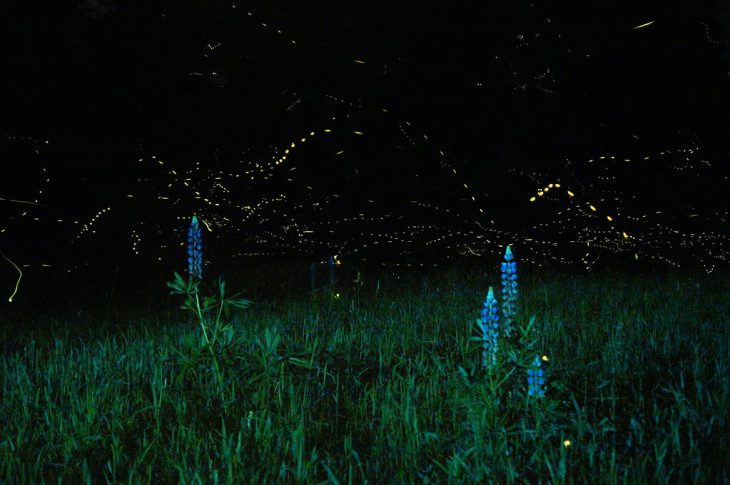Bioluminescence is when light is produced by living things through chemical reactions. Fireflies are probably one of the first organisms that comes to mind when thinking about bioluminescence.
There are not many fossils of fireflies. One of the few fossils is encased in amber (just like Jurassic Park!) and is from 100 million years ago. It has a light-emitting structure on its abdomen like modern fireflies. This is evidence that ancient bioluminescent fireflies were using their light for something. But why do fireflies have these lights in the first place? What was their purpose? Did the light look the same back then as it does now? To answer these questions, the scientists from Japan decided to reconstruct ancient proteins from the ancestors of fireflies and other luminescent beetles.
Fireflies produce light by using a protein named luciferase. There are two types of firefly luciferase genes in modern fireflies. They both originated from the ancient firefly luciferase gene. The first one (Luc1) is in charge of green-yellow light in larvae, pupae, and adults. The other one (Luc2) has a dim green glow in the eggs, the pupal body, and the ovaries.
Luciferases have another function besides making light. They can change a part of the structure of fats in the cells so that the fireflies can break them down to use in energy production. Scientists speculate that luciferase evolved from a fat metabolism enzyme. Even though the luciferase protein of fireflies and other beetles have this fat metabolism function, not all of them are able to produce light.
To reconstruct ancient firefly luciferase genes, they figured out what those proteins of both modern and ancient fireflies were made of. This meant determining which amino acids were present, and in what order. Then, they compared the proteins to see how similar or different they were from each other. This helped them group the proteins by how related they were to each other along the evolutionary timeline, using DNA from a 152 million year old fossil of a luminescent beetle as a reference point.
Using a computer program, they predicted sets of ancient luciferases that were statistically more likely to have existed back then. They settled on 7 different luciferase proteins. They constructed the genes for those proteins in the laboratory, and then introduced the gene into bacteria. The bacteria produced the protein like it was its own, so it could be extracted from the culture and purified. The scientists analyzed the purified luciferase enzymes to determine what colors they produced.

Firefly with green glowing light. Copyright Sciworthy 2021. Created in Canva.
The light is produced when a protein called luciferin binds to the luciferase enzyme. The color of the light can vary from green to orange-yellow and it depends on the amino acid sequence of luciferase. Amino acids have different physical structures and properties. There are some key amino acids in the structure of luciferase that can change how luciferin binds to it depending on these differences.
When they measured the light produced by the resurrected luciferases and their reactions with luciferin, they found that 100 million years ago, the ancestor of all fireflies produced green light. Approximately 70 millions years ago, this luciferase gene duplicated itself, and the ancestors of Luc1 and Luc2 came into existence. The ancestor Luc1 was yellow-green and the ancestor of Luc2 was green. 103 million years ago, one ancient luciferase produced orange light.
The last common ancestor of all of the luminescent beetles, including fireflies, had red light properties. However, this oldest luciferase, which was dated back to 115 million years ago, was not producing enough light to be detected. Therefore, it was non-luminescent which can be explained by the key amino acids in its sequence. The oldest luciferase also had significantly higher fat metabolism activity than other reconstructed and modern luciferases. This finding supports the hypothesis that the firefly luciferase evolved from an enzyme that had a fat metabolism function.
The scientists hypothesized that the common ancestor of fireflies evolved green light bioluminescence to warn nocturnal predators, which are active at night. Green luminescence is common in several luminescent organisms like mushrooms and millipedes. Nocturnal predators that are sensitive to toxins that produce green light would have been sickened or poisoned, allowing those green light producing insects to outcompete the others. Some species of fireflies may have even developed a secondary function for sexual communication to attract mates, using yellow light to differentiate from the green warning signal.
Why study ancient firefly bioluminescence? The authors explained that the purpose of this research was to determine if ancient gene reconstruction was a scientifically valid way to understand the past.


